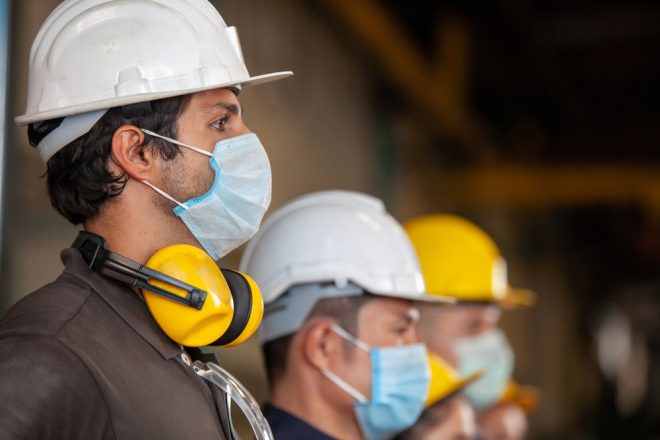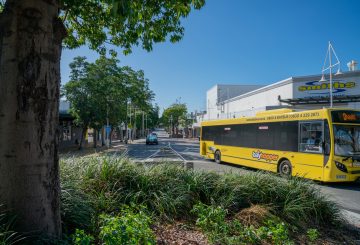警戒レベル2、3、4下では、一般の人と接するほとんどの労働者は、マスクを着用しなければなりません。
これには以下のような労働者が含まれます。
- 商品や食品を家庭に配達している人、ただし車に乗っていない時に限る。
- カフェ、レストラン、バー、その他の飲食物を提供するビジネスやサービスで顧客にサービスを提供している人
- 美容師、タトゥーアーティスト、マッサージ師、ビューティーセラピストなど、身近なサービスを提供している人
- 小売店、スーパーマーケット、酪農場、ガソリンスタンドなど、顧客に物を販売する類似の店舗で勤務している人
- 図書館、博物館、ジムなどの屋内公共施設で働いている人ただし、プールで働いている人は、顔面保護具を着用する必要はありません。
- タクシー、ライドシェア車、フェリー、バス、電車などの公共交通機関を運転する人スクールバスや北島と南島を結ぶフェリーは除きます。
- 警戒レベル3下で屋内のセカンダリースクールにいる人(開校している場合)この場合、教育を提供する、または提供をサポートするために働く生徒やスタッフには顔面被覆が義務付けられています。
この規則は、警戒レベル2、3、4で適用されます。ただし、上記のすべての事業者が警戒レベル3および4で営業できるわけではなく、非接触型の配送でしか営業できない事業者もおり、顧客との対話を行うべきではありません。
マスクを着用できない労働者への適用除外
障害や健康上の問題を抱えている労働者の中には、安全かつ快適にマスクを着用できない人もいます。その場合は、マスクを着用する必要はありません。企業は誠意をもってスタッフと協力し、スタッフの安全を確保するために他の安全衛生措置がないかどうかを確認する必要があります。
顧客や訪問者の中には、労働者がマスクを着用していないと安心できない人もいます。従業員に、顧客に見せることができる免除カードを申請してもらうことや、従業員がマスクを着用できない理由を顧客に伝える他の方法を提供することを検討してください。個人情報を開示することなく、高いレベルを維持してください。
免除カードは、NZ障害者協会(Disabled Persons Assembly NZ)に電話(04 801 9100)またはメール(info@dpa.org.nz)で請求できます。
労働者の中には、ひげを生やしているためにマスクを着用できないなど、個人的な理由でマスクを着用しない人もいます。個人的な理由によるマスクの着用義務の免除はありません。このような場合、企業は誠意をもって従業員と協力して状況を解決し、代替策を検討する必要があります。
また、一部の企業では、お客様にもマスクの着用が義務付けられています
これには、公共交通機関やタクシーを利用するとき、医療施設や高齢者介護施設を訪れるとき、スーパーマーケット、薬局、ショッピングモール、屋内市場、持ち帰り食品店などの小売業や、博物館や図書館などの公共施設などが含まれます。
クリック&コレクトサービスを利用する際(例:アラートレベル3下)には、マスクを着用する必要はありませんが、着用を推奨します。
12歳以上のお客様に限り、マスクの着用が義務付けられています。
障害や健康上の理由で、マスクを安全かつ快適に着用できない方は、着用の必要はありません。このような方は、免除カードを取得することができますが、それを携帯したり提示したりする必要はありません。
企業やサービスは、マスクを着用していない人が施設に入ることや交通機関に乗ることを止める必要はありません。なぜなら、マスクの着用が免除される人がいるからです。
企業は、その施設でマスクの着用を要求することができます。その際には、フェイスマスクの着用ができない障がい者を差別しないように注意する必要があります。
従業員や顧客が一時的にマスクを外すことができる状況もあります
健康上や障害上の理由による免除以外にも、以下のような状況ではフェイスカバーを一時的に外すことができます。
- お酒を買うときや金融取引をするときなど、相手の身元を確認するとき。
- 薬を服用するとき。
- 警戒レベルの規定により、現場で飲食が許可されている場合に、飲食をするため。
- 耳が不自由なため、コミュニケーションをとるために相手の口元を見る必要がある人と話すため。
このような場合でも、企業は物理的な距離を保つという要件を満たす必要があります。
顧客にマスクの着用を求める際に従業員の安全を確保する
警戒レベルの要件を満たすだけでなく、企業は2015年労働安全衛生法(HSWA)を含む他のすべての法律を引き続き遵守する必要があります。
企業は人々にマスクを着用させる義務はありませんが、着用を促すための措置をとることができます。
これらの措置を検討する際、企業は労働者の健康と安全を維持する方法を考えるべきです。これには、人々にマスクの着用を勧めている労働者に怒りを覚えた人がいた場合の対処法も含まれます。
マスクの着用を拒否した場合、企業は彼らにそれ以上の行動をとる必要はありません。
事態がエスカレートした場合にどうすべきかを含め、従業員が適切なサポート、指導、情報を得られるようにする必要があります。
労働者に対する情報提供、訓練、指導、監督(外部リンク) – WorkSafe
事態がエスカレートしたときに使用できる言葉をスタッフに伝え、状況を緩和できるようにすることを推奨します。労働者がどのような場合にその場を立ち去るべきか、あるいはその人との関わりを継続しないことを決めるべきかを明確にすることをお勧めします。労働者は、その仕事が自分や他の人を深刻な安全衛生上のリスクにさらすと考えられる場合、仕事を中止または拒否する権利があります。
情報は、WorkSafeのウェブサイトに掲載されています。
労働停止に関する問題解決のための支援要請(外部リンク) – WorkSafe
また、どのような行為が警察に通報される可能性があるのかを検討し、それを公表する必要があります。例えば、スタッフへの虐待は容認されないことを示す看板を設置することが考えられます。
マスクについての詳しい情報は、Unite Against Covidのウェブサイトをご覧ください。
マスクの着用(外部リンク) – covid19.govt.nz
























































-helped-regain-her-strength-and-balance-using-Nymbl-after-a-fall.-660x440.jpg)


